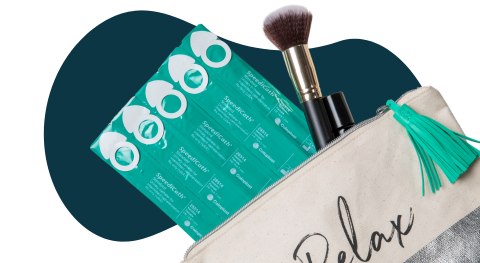
Since the introduction of clean intermittent catheterization to drain the bladder, intermittent catheter technology has continued to advance. No-touch catheters have become especially popular among catheter users. Find out why with our handy guide to no-touch catheters.
What is a No-Touch Catheter?
No-touch catheters (also known as touch-free catheters or touchless catheters) are advanced catheter products that keep self-catheterization more sterile. Generally, these are closed system catheters (sterile catheter kits) or hydrophilic catheters, where users can easily advance the catheter forward to insert without directly touching it. This minimizes the risk of contamination from the hands.
Catheter users often prefer this catheter type due to how easy and convenient they are to use. In addition, they may help reduce the risk of urinary tract infections (UTIs) and catheter-associated urinary tract infections (CAUTIs). Touch-free catheterization is shown to be quite effective at preventing catheter-associated UTIs in people with spinal cord injuries (SCI). Clinical studies demonstrated that the use of no-touch catheters is associated with a 30% UTI reduction.

Why Should I Use a No-Touch Catheter?
Many catheter users prefer no-touch catheters for many reasons. First, they’re often travel-ready and discreet. Plus, they’re convenient to use and carry. And, of course, the potential reduction of UTIs is an added bonus.
Types of No-Touch Catheters
Depending on your insurance coverage, you have several options from all catheter types when choosing a no-touch catheter.
To get started, reach out to us to verify your insurance’s catheter coverage and request free samples. 180 Medical offers a wide variety of catheter options from all major brands, and we’ll ship your orders discreetly to your door for free!
Closed System Catheters
Closed system catheters are the preferred cathing system for many, including people in wheelchairs, children, and those who frequently travel, work, or go to school.
These pre-lubricated catheters come ready to use inside their own sterile collection bags. Others may have a hydrophilic coating that is easily activated by sterile water to become lubricated. Closed system catheter kits often have everything you need to cath hygienically in an all-in-one package. Insertion supplies often include helpful cathing accessories like gloves and antiseptic wipes.
Another awesome feature of many closed system catheters is the soft, flexible introducer tip. The introducer tip works by shielding the tip of the catheter and helping it bypass the bacteria in the outermost section of the urethra. This may further help reduce the risk of UTIs.
Hydrophilic Catheters
If your insurance policy does not cover closed system catheters (billed under HCPC code A4353), you may be able to qualify for a hydrophilic catheter. Hydrophilic catheters either come pre-hydrated and ready to use or are easily activated by an included sterile water packet.
Once it’s ready to use, the catheter stays optimally lubricated and offers a smooth insertion. Hydrophilic catheters minimize urethral friction, which can also help reduce the risk of infection. Most hydrophilic catheters are no-touch catheters, thanks to included handling sleeves that keep your hands off the catheter tube.
The popular GentleCath Glide™, a no-touch hydrophilic catheter for both males and females, helps make cathing more comfortable. Its unique FeelClean Technology™ reduces the mess left behind by alternate brands of hydrophilic catheters. In addition, FeelClean Technology™ helps protect the delicate urethral tissue, which can ultimately help reduce the risk of UTIs.

Pre-Lubricated Catheters and Ready-to-Use Catheters
Pre-lubricated touch-free catheters offer an added level of ease and convenience. These catheters come pre-lubricated, eliminating the need for manual lubrication and reducing preparation time. Since the catheter is ready to use right out of the package, there’s no need to touch the catheter tube, which can help lower the risk of contamination.
Most touch-free catheters also feature guide sleeves, allowing you to insert the catheter without handling the tube directly, keeping your hands off the catheter itself. This makes self-cathing quicker and more hygienic, whether you’re at home or on the go. It’s a convenient, travel-friendly solution for anyone who values a simpler, more straightforward process.
Straight Catheters
Most intermittent straight catheters aren’t no-touch catheters. However, some brands, such as MTG, offer a straight catheter with a guide sleeve to make catheterization touch-free.
Even with uncoated catheters, there are ways to minimize direct hand contact and make self-catheterization more hygienic. Many users pair uncoated catheters with catheter insertion supplies like antiseptic wipes, gloves, and catheter insertion kits. These tools help keep the process as touch-free as possible.
By using gloves or handling the catheter by its funnel, you can still reduce direct contact with the catheter tube. Talk to our trained specialists to explore your options and learn how to catheterize hygienically.
Where to Buy No-Touch Catheters
Still not sure which catheter option is right for you? Contact us today and speak with a trained catheter specialist who can help you decide which insurance-covered intermittent catheter is best for your unique circumstances. Your health is too important to risk not using the right catheter product.
Disclaimer: Please note that this post is not medical advice. This information should not be used in place of your professional healthcare provider’s recommendations and medical advice.
Sources: Bennett CJ, Young MN and Darrington H. PubMed. 1995.
Bennett CJ, Young MN, Razi SS, Adkins R, Diaz F, McCrary A. PubMed. 1997.



